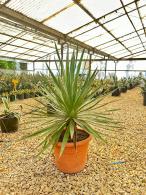Get Additional 5% Off 1st Order
Aloe Vera
1. Add items to basket
2. Go to the basket
3. Enter your postcode in Delivery Price Check
Plant shape: Spiky Looking-Not Cold Hardy
Pot size: 5-7 Litres
Plant ID: 2357 64
click to view this plant size >
Aloe Vera, also known as the First Aid plant or Medicinal aloe or even Barbados Aloe, has been grown for its healing properties for years. Of late, it is popular for its use in cosmetics and alternative medicines (be careful not to ingest it though, it can cause severe discomfort if eaten). This evergreen succulent has fleshy leaves and thick serrated edges that arise from a stemless rosette. When it does flower, it will bloom in early summer and produce a greenish/yellow coloured, tubular flower on spikes; but it is really the striking green succulent leaves that give this plant its unique beauty.
The botanical name, Aloe Vera is also known as Aloe barbadensis, Aloe perfollata, Bargados aloe, Bitter aloes, and Curacao aloe. The Genus Aloe and species A. vera is considered an evergreen with multi stemmed palm, cycad, or tree growth habit. It is a native of the arid regions of north-eastern and southern parts of Africa, Madagascar, Southern Europe, and the Canary Islands. It can be found throughout the tropical regions of the world today. In terms of its hardiness, it does need to be protected from extreme cold and will not thrive in persistently harsh and exposed aspects.
Barbados Aloe will reach ultimate growth to about 0.6-1.0 metres and an ultimate spread of about 0.6-1.0 metres as well. It takes between 5-10 years to reach its maximum growth. A winner of the Royal Horticultural Society’s Award of Garden Merit, it is grown widely around the world. Aloe Vera prefers bright light. Use a good potting compost in the media as it likes fertile soil. It responds best to watering all at once after allowing the soil to dry out, then heavily watering to soak the root zone well but allow the water to drain out of the container freely. This slow grower is also known to remove toxins from the air when grown in indoor environments; and interestingly, it will release oxygen and absorb carbon dioxide in the dark.
Using a balanced potting mix with a good amount of mature compost in the blend is a good idea, and will likely provide the pH it prefers, near neutral, slightly acidic, or slightly alkaline.












